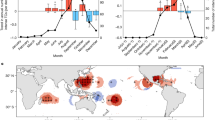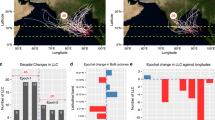Abstract
The assessment of changes in tropical cyclone activity within the context of anthropogenically influenced climate change has been limited by the short temporal resolution of the instrumental tropical cyclone record1,2 (less than 50 years). Furthermore, controversy exists regarding the robustness of the observational record, especially before 19903,4,5. Here we show, on the basis of a new tropical cyclone activity index (CAI), that the present low levels of storm activity on the mid west and northeast coasts of Australia are unprecedented over the past 550 to 1,500 years. The CAI allows for a direct comparison between the modern instrumental record and long-term palaeotempest (prehistoric tropical cyclone) records derived from the 18O/16O ratio of seasonally accreting carbonate layers of actively growing stalagmites. Our results reveal a repeated multicentennial cycle of tropical cyclone activity, the most recent of which commenced around ad 1700. The present cycle includes a sharp decrease in activity after 1960 in Western Australia. This is in contrast to the increasing frequency and destructiveness of Northern Hemisphere tropical cyclones since 1970 in the Atlantic Ocean6,7,8 and the western North Pacific Ocean6,7. Other studies project a decrease in the frequency of tropical cyclones towards the end of the twenty-first century in the southwest Pacific7,9, southern Indian9,10 and Australian11 regions. Our results, although based on a limited record, suggest that this may be occurring much earlier than expected.
This is a preview of subscription content, access via your institution
Access options
Subscribe to this journal
Receive 51 print issues and online access
$199.00 per year
only $3.90 per issue
Buy this article
- Purchase on Springer Link
- Instant access to full article PDF
Prices may be subject to local taxes which are calculated during checkout



Similar content being viewed by others
References
Knutson, T. R. et al. Tropical cyclones and climate change. Nature Geosci. 3, 157–163 (2010)
Nott, J. & Hayne, M. High frequency of ‘super-cyclones’ along the Great Barrier Reef over the past 5,000 years. Nature 413, 508–512 (2001)
Landsea, C. W., Harper, B. A., Hoarau, K. & Knaff, J. A. Climate change: can we detect trends in extreme tropical cyclones? Science 313, 452–454 (2006)
Harper, B. A., Stroud, S. A., McCormack, M. & West, S. A. A review of historical tropical cyclone intensity in north-western Australia and implications for climate change trend analysis. Aust. Meteorol. Mag. 57, 121–141 (2008)
Kamahori, H., Yamazaki, N., Mannoji, N. & Takahashi, K. Variability in intense tropical cyclone days in the western North Pacific. SOLA 2, 104–107 (2006)
Emanuel, K. Increasing destructiveness of tropical cyclones over the past 30 years. Nature 436, 686–688 (2005)
Emanuel, K., Sundararajan, R. & Williams, J. Hurricanes and global warming: results from downscaling IPCC AR4 simulations. Bull. Am. Meteorol. Soc. 89, 347–367 (2008)
Elsner, J. B., Kossin, J. P. & Jagger, T. H. The increasing intensity of the strongest tropical cyclones. Nature 455, 92–95 (2008)
Oouchi, K. et al. Tropical cyclone climatology in a global-warming climate as simulated in a 20 km-mesh global atmospheric model: frequency and wind intensity analyses. J. Meteorol. Soc. Jpn 84, 259–276 (2006)
Zhao, M., Held, I. M., Lin, S. J. & Vecchi, G. A. Simulations of global hurricane climatology, interannual variability, and response to global warming using a 50-km resolution GCM. J. Clim. 22, 6653–6678 (2009)
Abbs, D. The Impact of Climate Change on the Climatology of Tropical Cyclones in the Australian Region. CAF Working Paper 11 (CSIRO, 2010)
Nicholls, N., Landsea, C. & Gill, J. Recent trends in Australian region tropical cyclone activity. Meteorol. Atmos. Phys. 65, 197–205 (1998)
Kossin, J. P. et al. A globally consistent reanalysis of hurricane variability and trends. Geophys. Res. Lett. 34, L04815 (2007)
Bell, G. D. et al. Climate Assessment for 1999. Bull. Am. Meteorol. Soc. 81, 1328 (2000)
Yu, J. Y., Chou, C. & Chiu, P. G. A revised accumulated cyclone energy index. Geophys. Res. Lett. 36, L14710 (2009)
Kantha, L. Time to replace the Saffir-Simpson hurricane scale? Eos 87, 3–6 (2006)
Gedzelman, S., Lawrence, J., Gamache, J. & Black, M. Probing hurricanes with stable isotopes of rain and water vapor. Mon. Weath. Rev. 131, 1112–1127 (2003)
Lawrence, J. R., Gedzelman, S. D., Zhang, X. & Arnold, R. Stable isotope ratios of rain and vapor in 1995 hurricanes. J. Geophys. Res. 103, 11381–11400 (1998)
Frappier, A. B. et al. Stalagmite stable isotope record of recent tropical cyclone events. Geology 35, 111–114 (2007)
Nott, J., Haig, J., Neil, H. & Gillieson, D. Greater frequency variability of landfalling tropical cyclones at centennial compared to seasonal and decadal scales. Earth Planet. Sci. Lett. 255, 367–372 (2007)
Mühlinghaus, C., Scholz, D. & Mangini, A. Modelling fractionation of stable isotopes in stalagmites. Geochim. Cosmochim. Acta 73, 7275–7289 (2009)
Griffiths, M. L. et al. Increasing Australian-Indonesian monsoon rainfall linked to early Holocene sea-level rise. Nature Geosci. 2, 636–639 (2009)
Bureau of Meteorology. Australian Tropical Cyclone Database. Previous Tropical Cyclones (12 March 2012)
Liu, K. S. & Chan, J. C. L. Interannual variation of Southern Hemisphere tropical cyclone activity and seasonal forecast of tropical cyclone number in the Australian region. Int. J. Climatol. 32, 190–202 (2012)
Hassim, M. E. E. & Walsh, K. J. E. Tropical cyclone trends in the Australian region. Geochem. Geophys. Geosyst. 9, Q07V07 (2008)
Webster, P. J., Holland, G. J., Curry, J. A. & Chang, H. R. Changes in tropical cyclone number, duration, and intensity in a warming environment. Science 309, 1844–1846 (2005)
Mann, M. E. & Emanuel, K. A. Atlantic hurricane trends linked to climate change. Eos Trans. AGU 87, 233–241 (2006)
Callaghan, J. & Power, S. Variability and decline in the number of severe tropical cyclones making land-fall over eastern Australia since the late nineteenth century. Clim. Dyn. 37, 647–662 (2011)
Braganza, K. et al. in Climate Science Update: A Report to the 2011 Garnaut Review (eds Keenan, T. D. & Cleugh, H. A. ) 3–16 (Centre for Australian Weather and Climate Research, 2011)
Hendy, C. H. The isotopic geochemistry of speleothems–I. The calculation of the effects of different modes of formation on the isotopic composition of speleothems and their applicability as palaeoclimatic indicators. Geochim. Cosmochim. Acta 35, 801–824 (1971)
Mann, M. E. Smoothing of climate time series revisited. Geophys. Res. Lett. 35, L16708 (2008)
NOAA. HURDAT Best Track Data. NOAA Hurricane Research Division of AOMLhttp://www.aoml.noaa.gov/hrd/hurdat/tracks1949to2011_epa.html (13 March 2013)
Lawrence, J. R., Gedzelman, S. D., Gamache, J. & Black, M. Stable isotope ratios: Hurricane Olivia. J. Atmos. Chem. 41, 67–82 (2002)
Liu, J. et al. Stable isotopic compositions in Australian precipitation. J. Geophys. Res. 115, D23307 (2010)
Atkinson, G. D. & Holliday, C. R. Tropical cyclone minimum sea level pressure/maximum sustained wind relationship for the western North Pacific. Mon. Weath. Rev. 105, 421–427 (1977)
Velden, C. et al. The Dvorak tropical cyclone intensity estimation technique: a satellite-based method that has endured for over 30 years. Bull. Am. Meteorol. Soc. 87, 1195–1210 (2006)
Willoughby, H. E. & Rahn, M. E. Parametric representation of the primary hurricane vortex. Part I: Observations and evaluation of the Holland (1980) model. Mon. Weath. Rev. 132, 3033–3048 (2004)
Acknowledgements
Funding for this project was provided by the Australian Research Council (ARC) Discovery Projects Scheme (reference number DP0772691) and financial assistance given as part of the Queensland Smart State Initiative. Analytical procedures were conducted at James Cook University and the University of Utrecht. Special thanks are extended to C. Zwart for his input and advice regarding the development of CAI and his editing of this manuscript. Additional thanks are extended to A. van Dijk and L. Lourens for technical help with IRMS analyses.
Author information
Authors and Affiliations
Contributions
J.N. collected the two stalagmites, provided funding for the project through the ARC grant and participated in critical discussions on the development of CAI. G.-J.R. provided access to facilities and advice on the data processing. J.H. helped collect one stalagmite, processed both stalagmites, analysed the data, developed and tested CAI, and wrote the manuscript. All authors discussed the results and commented on the manuscript.
Corresponding author
Ethics declarations
Competing interests
The authors declare no competing financial interests.
Extended data figures and tables
Extended Data Figure 1 δ18O VSMOW measured from Hurricane Olivia (1995) versus the calculated Kt values for the corresponding measurement interval.
a, δ18O versus Kt for all rain types in Hurricane Olivia. r = −0.58, P = 0.02, n = 25. b, δ18O versus Kt within the eye wall. Shaded area indicates the r.m.s.e. r = −0.70, P = 0.02, n = 15.
Supplementary information
Supplementary Data
This file contains the original wet season stalagmite carbonate data (δ18OC) for both sites: Cape Range, Western Australia (δ18OCR-1) and Chillagoe, Queensland (δ18OCH-1) from 511AD to 2010AD. Samples were milled from the stalagmite profiles using a video-controlled Micromill. All measurements are reported relative to Vienna PeeDee Belemnite (VPDB). (XLS 114 kb)
Rights and permissions
About this article
Cite this article
Haig, J., Nott, J. & Reichart, GJ. Australian tropical cyclone activity lower than at any time over the past 550–1,500 years. Nature 505, 667–671 (2014). https://doi.org/10.1038/nature12882
Received:
Accepted:
Published:
Issue Date:
DOI: https://doi.org/10.1038/nature12882
Comments
By submitting a comment you agree to abide by our Terms and Community Guidelines. If you find something abusive or that does not comply with our terms or guidelines please flag it as inappropriate.



